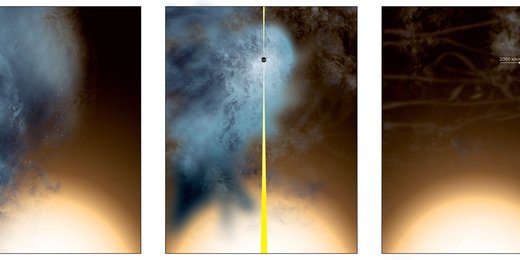| Topic: scientists find a "rouge" black hole | |
|---|---|

http://www.inverse.com/article/23268-naked-black-hole-streaks-through-space Black holes are mysterious cosmic monsters, shrouded in a thick veil of gas and dust. They lurk in the heart of galaxies, waiting to gobble up stars that get too close, before belching deadly x-rays in satisfaction. However, astronomers recently spotted a strange black hole, streaking through space. At first glance, this rogue specimen just seemed out of place, but upon further study, astronomers realized they had stumbled upon the remains of a grisly cosmic scene. Unlike most black holes, the subject in question — dubbed B3 1715+425 — was not in the center of a galaxy. Even more surprisingly, it appeared to be "naked", meaning it was devoid of a black hole's typical stellar shroud. "We've not seen anything like this before," James Condon, an astronomer at the National Radio Astronomy Observatory and lead author of the study, said in a news release. B3 1715+425 is a supermassive black hole residing on the fringes of an unusually small, faint galaxy. Like most supermassive black holes, it was doing its thing, munching on stars and spewing out deadly x-rays when it overindulged. That routine continued for billions of years until B3 1715+425's host galaxy slammed into a larger galaxy. This type of cosmic collision is commonplace, especially within larger galaxy clusters, like ZwCl 8193, where B3 1715+425's galaxy lives. Astronomers think that the largest galaxies in the universe formed through galaxy mergers. Typically when galaxies merge, the two black holes within those galaxies take part in a dramatic orbital dance, with the pair orbiting each other until they eventually combine. (The LIGO experiment saw proof of this last September). Most of the time, this merging process seems to go rather smoothly, as nearly all galaxies host a supermassive black hole, the majority of which are located at the galactic center. However, in the case of B3 1715+425 something went very wrong. B3 1715+425 was stripped of its stars as it tried to escape the clutches of a larger galaxy, and astronomers caught it in the act. Using the National Science Foundation's Very Long Baseline Array (VBLA) — a network of ten 25-meter dish antennas spread across the globe and operated out of New Mexico — astronomers clocked the rogue behemoth racing away from the cosmic collision at more than 2,000 miles per second. "We were looking for orbiting pairs of supermassive black holes, with one offset from the center of a galaxy, as telltale evidence of a previous galaxy merger," Condon said. "Instead, we found this black hole fleeing from the larger galaxy and leaving a trail of debris behind it." As it streaks through space, B3 1715+425 is steadily hemorrhaging ionized gas — the fuel needed to form new stars. Once that gas supply is gone, the galaxy will become invisible, which astronomers expect to see in the next billion years. Are there other black holes like B3 1715+425 out there? Condon and team think there are, and they will be scanning the cosmos with the VBLA to find them. |
|
|
|
|
|
This could be the black hole i once mentioned a while back...I think in one of the science threads not sure.
This black hole will have alien beings come through it at a specific time & they will reign havoc on earth. Astronomers have not seen anything like it before coz it could possibly be the same black hole i'm referring to... Thanks for this thread 
|
|
|
|
|
|
scientists find a "rouge" black hole __________________________________________________________________ Bobby Brown? |
|
|
|
|

http://www.inverse.com/article/23268-naked-black-hole-streaks-through-space Black holes are mysterious cosmic monsters, shrouded in a thick veil of gas and dust. They lurk in the heart of galaxies, waiting to gobble up stars that get too close, before belching deadly x-rays in satisfaction. However, astronomers recently spotted a strange black hole, streaking through space. At first glance, this rogue specimen just seemed out of place, but upon further study, astronomers realized they had stumbled upon the remains of a grisly cosmic scene. Unlike most black holes, the subject in question — dubbed B3 1715+425 — was not in the center of a galaxy. Even more surprisingly, it appeared to be "naked", meaning it was devoid of a black hole's typical stellar shroud. "We've not seen anything like this before," James Condon, an astronomer at the National Radio Astronomy Observatory and lead author of the study, said in a news release. B3 1715+425 is a supermassive black hole residing on the fringes of an unusually small, faint galaxy. Like most supermassive black holes, it was doing its thing, munching on stars and spewing out deadly x-rays when it overindulged. That routine continued for billions of years until B3 1715+425's host galaxy slammed into a larger galaxy. This type of cosmic collision is commonplace, especially within larger galaxy clusters, like ZwCl 8193, where B3 1715+425's galaxy lives. Astronomers think that the largest galaxies in the universe formed through galaxy mergers. Typically when galaxies merge, the two black holes within those galaxies take part in a dramatic orbital dance, with the pair orbiting each other until they eventually combine. (The LIGO experiment saw proof of this last September). Most of the time, this merging process seems to go rather smoothly, as nearly all galaxies host a supermassive black hole, the majority of which are located at the galactic center. However, in the case of B3 1715+425 something went very wrong. B3 1715+425 was stripped of its stars as it tried to escape the clutches of a larger galaxy, and astronomers caught it in the act. Using the National Science Foundation's Very Long Baseline Array (VBLA) — a network of ten 25-meter dish antennas spread across the globe and operated out of New Mexico — astronomers clocked the rogue behemoth racing away from the cosmic collision at more than 2,000 miles per second. "We were looking for orbiting pairs of supermassive black holes, with one offset from the center of a galaxy, as telltale evidence of a previous galaxy merger," Condon said. "Instead, we found this black hole fleeing from the larger galaxy and leaving a trail of debris behind it." As it streaks through space, B3 1715+425 is steadily hemorrhaging ionized gas — the fuel needed to form new stars. Once that gas supply is gone, the galaxy will become invisible, which astronomers expect to see in the next billion years. Are there other black holes like B3 1715+425 out there? Condon and team think there are, and they will be scanning the cosmos with the VBLA to find them. I'm confused by the term fleeing. Given the gravitational pull inherent to mass, which causes bodies to attract-- and accounts for the stripping, how does one conclude that the smaller is 'fleeing'? Aren't they just continuing their incidental trajectories, with the larger consuming the smaller's satellite bodies as they're overtaken by the gravitational pull of the larger, which is travelling at a higher velocity? |
|
|
|
|
|
scientists find a "rouge" black hole __________________________________________________________________ Bobby Brown?                   : :     
|
|
|
|
|

http://www.inverse.com/article/23268-naked-black-hole-streaks-through-space Black holes are mysterious cosmic monsters, shrouded in a thick veil of gas and dust. They lurk in the heart of galaxies, waiting to gobble up stars that get too close, before belching deadly x-rays in satisfaction. However, astronomers recently spotted a strange black hole, streaking through space. At first glance, this rogue specimen just seemed out of place, but upon further study, astronomers realized they had stumbled upon the remains of a grisly cosmic scene. Unlike most black holes, the subject in question — dubbed B3 1715+425 — was not in the center of a galaxy. Even more surprisingly, it appeared to be "naked", meaning it was devoid of a black hole's typical stellar shroud. "We've not seen anything like this before," James Condon, an astronomer at the National Radio Astronomy Observatory and lead author of the study, said in a news release. B3 1715+425 is a supermassive black hole residing on the fringes of an unusually small, faint galaxy. Like most supermassive black holes, it was doing its thing, munching on stars and spewing out deadly x-rays when it overindulged. That routine continued for billions of years until B3 1715+425's host galaxy slammed into a larger galaxy. This type of cosmic collision is commonplace, especially within larger galaxy clusters, like ZwCl 8193, where B3 1715+425's galaxy lives. Astronomers think that the largest galaxies in the universe formed through galaxy mergers. Typically when galaxies merge, the two black holes within those galaxies take part in a dramatic orbital dance, with the pair orbiting each other until they eventually combine. (The LIGO experiment saw proof of this last September). Most of the time, this merging process seems to go rather smoothly, as nearly all galaxies host a supermassive black hole, the majority of which are located at the galactic center. However, in the case of B3 1715+425 something went very wrong. B3 1715+425 was stripped of its stars as it tried to escape the clutches of a larger galaxy, and astronomers caught it in the act. Using the National Science Foundation's Very Long Baseline Array (VBLA) — a network of ten 25-meter dish antennas spread across the globe and operated out of New Mexico — astronomers clocked the rogue behemoth racing away from the cosmic collision at more than 2,000 miles per second. "We were looking for orbiting pairs of supermassive black holes, with one offset from the center of a galaxy, as telltale evidence of a previous galaxy merger," Condon said. "Instead, we found this black hole fleeing from the larger galaxy and leaving a trail of debris behind it." As it streaks through space, B3 1715+425 is steadily hemorrhaging ionized gas — the fuel needed to form new stars. Once that gas supply is gone, the galaxy will become invisible, which astronomers expect to see in the next billion years. Are there other black holes like B3 1715+425 out there? Condon and team think there are, and they will be scanning the cosmos with the VBLA to find them. I'm confused by the term fleeing. Given the gravitational pull inherent to mass, which causes bodies to attract-- and accounts for the stripping, how does one conclude that the smaller is 'fleeing'? Aren't they just continuing their incidental trajectories, with the larger consuming the smaller's satellite bodies as they're overtaken by the gravitational pull of the larger, which is travelling at a higher velocity? yes, you're right, but this is the first time they've seen this happen... it also means (mathematically) there are more free floating BH's in the universe... |
|
|
|
|
|
More likely, the term "fleeing" is just reporter "artistry." I call it sloppiness myself, but for some, it's a way to make an otherwise clinical science story sound more interesting.
The black hole was not "fleeing," it was apparently "exiting" what had now become entirely the larger Galaxy's collection of star systems. Of course, it's possible something else actually happened, since we only have the immediate pictures and readings. So it might be more accurate to say that most scientists BELIEVE that this is what happened, but sometimes accuracy like that, especially these days, encourages the fanatically or insistently ignorant, to run off in a nonsense direction. |
|
|
|
|
|
It always amazes me that they can find .. such things!. I have a hard enough time just finding my keys some days..lol
|
|
|
|
|
|
Hey, hey.... let's not discriminate. How do we know this black hole is rouge??? He might just be slumming!
Wave your butt good by as it passes! I hear spagetification is kind of a rush! |
|
|
|
|
|
You naturally meant "Rogue". Otherwise we'd not only have a Black Hole here, but a powdered Reddish/Black Hole. It must be female and now my mind wanders...;)
|
|
|
|
|












